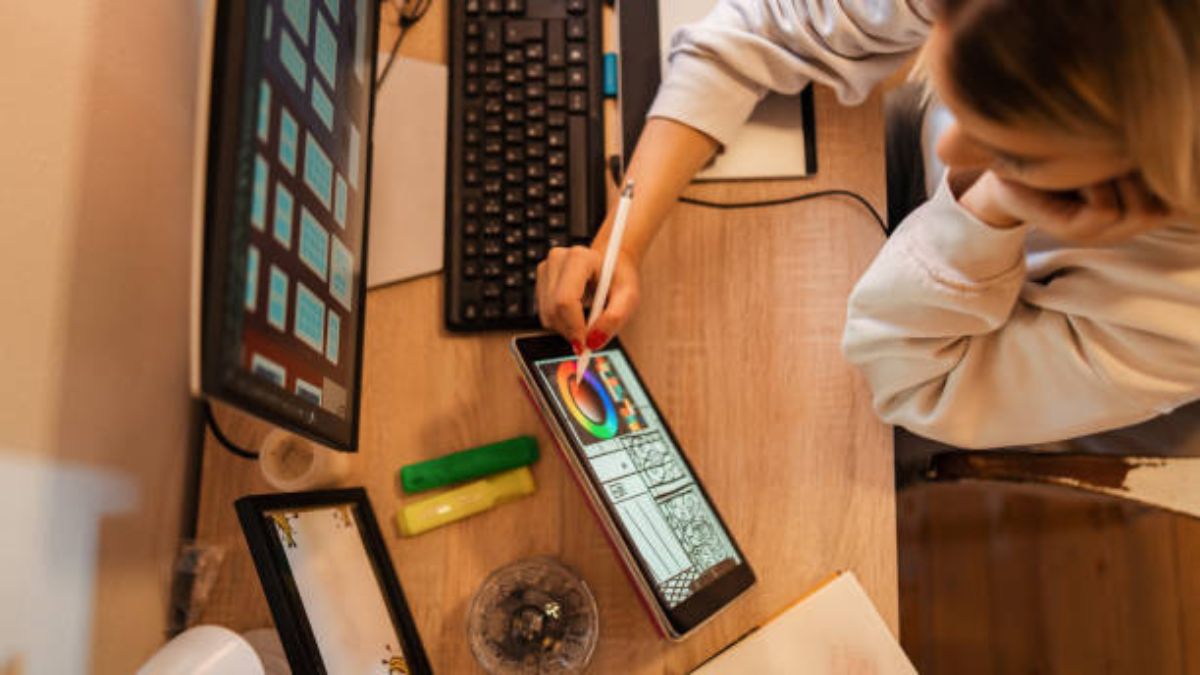Graphic design skills are more important today than ever before. In a world that is becoming increasingly visual, the ability to create visually appealing and engaging content is crucial. Graphic design not only helps to convey a message effectively but also plays a significant role in building brand identity and establishing professional credibility.
Firstly, graphic design skills enable designers to communicate complex ideas and information in a visually appealing manner. With the rise of social media platforms and digital marketing, it has become essential for businesses to capture the attention of their target audience quickly. Eye-catching graphics can help grab attention and convey information efficiently, leading to increased engagement and conversions.
Additionally, graphic design skills play a vital role in shaping the brand identity of individual businesses or organisations. A well-designed logo, colour scheme, or overall visual aesthetic can leave a lasting impression on consumers’ minds and help differentiate one brand from another in a saturated market. Consistency in design across various platforms also helps establish professionalism and trust among customers.
In conclusion, graphic design skills are no longer just an advantage but an absolute necessity in today’s visual-driven world. The ability to effectively communicate ideas through visually appealing designs enables businesses to stand out from competitors, engage their audience effectively, and build lasting brand loyalty. As technology continues to evolve rapidly with new innovations like augmented reality and virtual reality on the horizon, graphic designers must continually adapt their skills to meet emerging demands for compelling visuals across various platforms.
Technical Skills: Software proficiency and technical knowledge
In today’s digital age, technical skills are crucial for graphic designers to stay competitive and meet the demands of the industry. One of the most important technical skills for a graphic designer is software proficiency. Being well-versed in popular design software such as Adobe Creative Suite (including Photoshop, Illustrator, and InDesign) is essential. These tools allow designers to create stunning visuals, manipulate images, and layout designs with precision.
Furthermore, graphic designers should possess extensive technical knowledge that goes beyond just knowing how to use software. They need to understand colour theory, typography principles, and image optimization techniques. This knowledge helps them make informed decisions about which fonts to use, how colours interact with each other, and how to optimise file sizes without sacrificing quality. Additionally, having a good grasp of HTML and CSS can be advantageous when working on web design projects.
Ultimately, possessing strong technical skills not only enhances a graphic designer’s abilities but also makes them more adaptable in an ever-evolving industry. By staying up-to-date with the latest design software advancements and continually expanding their technical knowledge base through online courses or tutorials, designers can bring fresh ideas and perspectives to their work while meeting client expectations in this highly competitive field.
Creativity: Ability to think outside the box
Creativity is undoubtedly one of the most important skills for a graphic designer. It is the ability to think outside the box and come up with unique and innovative ideas that set a designer apart from the rest. In an industry that thrives on visually captivating designs, being able to push boundaries and break traditional norms is crucial.
Thinking outside the box allows graphic designers to bring new perspectives and fresh ideas to their work. It means they are not limited by preconceived notions or constrained by what has been done before. This freedom enables designers to explore different avenues, experiment with various techniques, and ultimately deliver exceptional visual solutions for their clients.
Moreover, creativity goes beyond just visuals in the world of graphic design. Designers must constantly adapt and find creative ways to utilise technology advancements in their workflow. They need to master new software programs, learn coding languages, and keep up with ever-evolving trends in digital design. Being open-minded and willing to embrace change is essential when navigating this rapidly changing landscape.
In conclusion, creativity remains a cornerstone skill for any successful graphic designer today. The ability to think outside the box not only allows designers to craft visually appealing designs but also paves the way for innovation, exploration of new techniques, adaptation of technology advancements, and meeting client needs effectively in an ever-evolving industry.
Communication: Effective communication and collaboration skills
In the field of graphic design, effective communication and collaboration skills are absolutely essential. While technical expertise and artistic talent are certainly important, being able to communicate ideas and collaborate with others effectively is what truly sets outstanding designers apart.
Communication is the foundation of any successful design project. Graphic designers need to be able to clearly articulate their vision, goals, and requirements to clients or stakeholders. They must also be active listeners who can understand and interpret feedback in order to create designs that meet the client’s objectives.
Collaboration is equally important as it allows designers to draw on the expertise of others and work towards a common goal. This may involve collaborating with copywriters, marketers, or other designers within a team setting. By working collaboratively, designers can benefit from different viewpoints and perspectives that lead to new ideas and innovative solutions.
Ultimately, mastering effective communication and collaboration skills not only improves the quality of a designer’s work but also strengthens relationships with clients and colleagues. It ensures that everyone involved is aligned on objectives, reduces misunderstandings or misinterpretations, and encourages open dialogue for continuous improvement throughout the creative process.
Time Management: Ability to meet deadlines and manage projects
Time management is a critical skill for graphic designers, as it enables them to meet deadlines and effectively manage projects. As the demand for graphic design continues to grow, clients and employers are increasingly looking for professionals who can efficiently handle multiple assignments without compromising quality. With effective time management, graphic designers can ensure that they complete their work on time, leaving a positive impression on their clients and supervisors.
One aspect of time management that is particularly relevant in the field of graphic design is the ability to prioritise tasks. Graphic designers often have numerous projects running concurrently, each with its own set of deadlines. By prioritising tasks based on their importance and urgency, designers can allocate their time and resources accordingly, ensuring that crucial projects are completed first while still giving attention to others.
Another essential component of effective project management is setting realistic deadlines. Unrealistic or excessively tight deadlines can lead to unnecessary stress and subpar work quality. Graphic designers should communicate with clients or supervisors at the outset of a project to establish feasible timelines based on the complexity and scope of the work required. This open dialogue ensures that all parties have a clear understanding of what can be achieved within the given timeframe.
By mastering time management skills like task prioritization and setting realistic deadlines, graphic designers position themselves as reliable professionals capable of meeting client expectations consistently. In such a competitive industry with increasing demands from clients for quick turnaround times, professionals who excel in these areas will stand out among their peers while ensuring successful project completion within allocated timeframes.
Problem-Solving: Analytical and problem-solving abilities
Analytical and problem-solving abilities are essential skills for a graphic designer. The field of design often presents complex challenges that require a creative yet analytical approach to find effective solutions. A good graphic designer not only needs to have a keen eye for aesthetics but also the ability to think critically and solve problems efficiently.
One of the key aspects of problem-solving in graphic design is understanding the client’s needs and goals. This requires active listening, effective communication, and the ability to ask relevant questions. By thoroughly analysing the problem at hand, a graphic designer can come up with innovative solutions that meet the client’s objectives while staying within budget and timeline constraints.
In addition, being able to think analytically helps designers examine different perspectives and consider all possible options before settling on one solution. This involves conducting thorough research, gathering data, and evaluating various approaches before making an informed decision. By applying logical reasoning to their creative process, graphic designers can create designs that are not only visually appealing but also resonate with their target audience.
Ultimately, having strong analytical and problem-solving abilities allows graphic designers to tackle complex design projects efficiently while delivering high-quality results that meet both client expectations and industry standards. These skills set them apart in an increasingly competitive market where innovation is crucial for success.
Demand for Graphic Designers: Growing demand in various industries
The demand for graphic designers is skyrocketing across various industries as businesses recognize the vital role they play in creating visually appealing and effective marketing materials. From e-commerce to social media, companies need skilled graphic designers to help them stand out in today’s crowded marketplace. In the digital age, where visual content dominates online platforms, having a strong visual identity is essential for attracting and retaining customers.
Moreover, with the increasing importance of user experience (UX) design in websites and apps, graphic designers are sought after to create intuitive and visually stunning interfaces. This demand extends beyond traditional design agencies and encompasses industries such as technology, finance, healthcare, and even government organisations. As these sectors embrace advancements in technology and prioritise aesthetics alongside functionality, graphic designers who possess a diverse skill set that can cater to their specific needs are in high demand.
In conclusion, the demand for graphic designers continues to grow across various industries due to their ability to craft visually captivating designs that engage audiences on multiple platforms. With businesses realising the impact of strong visual branding on customer perception and loyalty, graphic designers are becoming indispensable assets. Whether it’s designing eye-catching advertisements or creating user-friendly interfaces, their skills are pivotal in helping companies thrive in an increasingly competitive market landscape.
Conclusion: Summary of key skills and their importance in graphic design.
In conclusion, the key skills required for a successful graphic designer are vast and varied. Firstly, creativity is at the forefront of any design process. It enables designers to think outside the box, come up with unique ideas, and create visually appealing designs that captivate the target audience. Being able to communicate through design effectively is also crucial. Graphic designers must be able to convey messages clearly and concisely using various visual elements such as colour schemes, typography, and layout.
Additionally, technical proficiency is an essential skill in today’s digital age. Designers need to have a solid understanding of design software like Adobe Creative Suite and be proficient in other relevant tools and technologies. Good time management skills are also important, as designers often have multiple projects with tight deadlines. They must be able to prioritise tasks efficiently and deliver high-quality work within given timelines.
Overall, these skills play a vital role in making graphic designers successful in their careers. Without them, they would struggle to meet client expectations, stay competitive in the industry or produce innovative designs that truly resonate with audiences. As demand for graphic designers continues to rise across various industries, mastering these key skills will give aspiring designers a clear advantage and ensure their success in this dynamic field.




